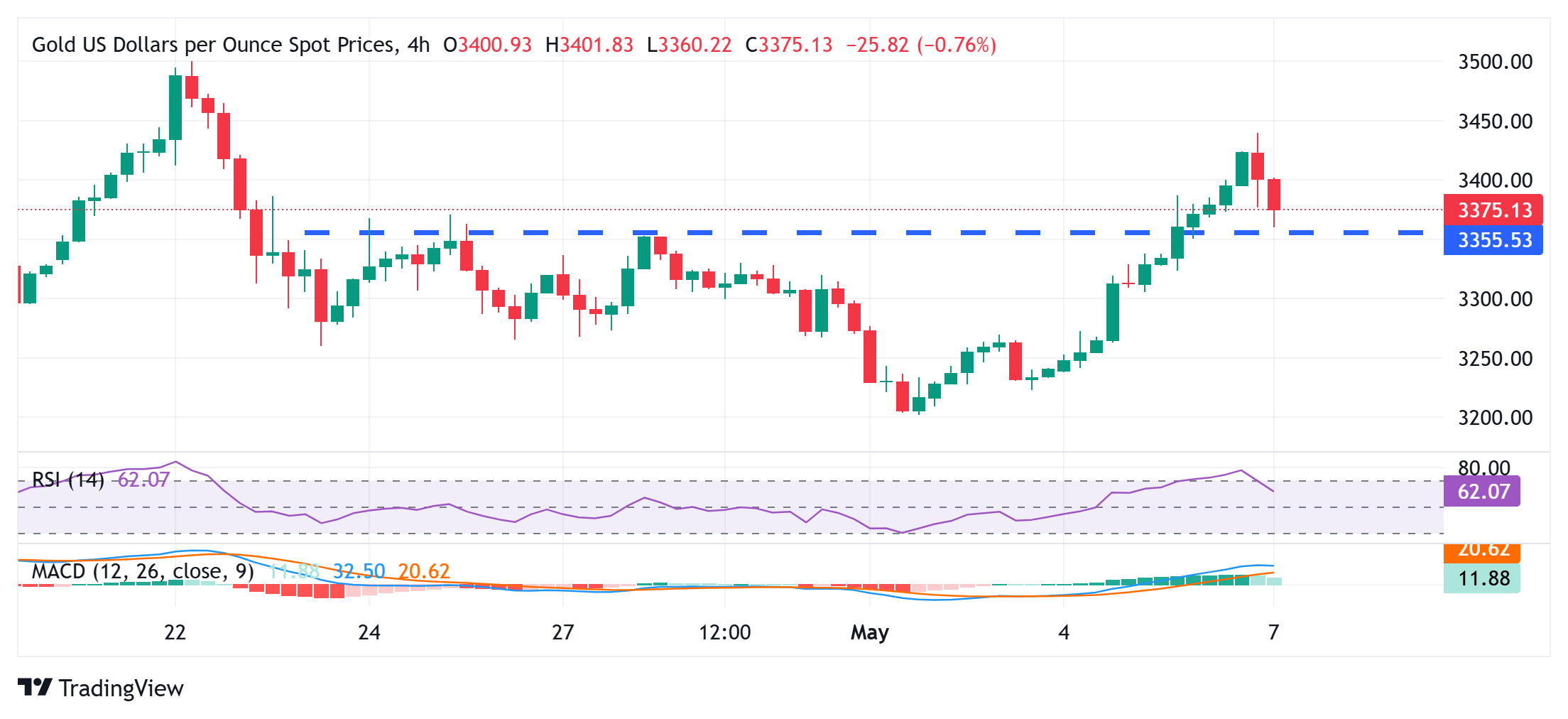- Gold price struggles to capitalize on its weekly gains registered over the past two days.
- The optimism over US-China trade talks is seen weighing on the safe-haven commodity.
- Investors now look to the crucial FOMC policy decision for a fresh directional impetus.
Gold price (XAU/USD) attracts heavy selling during the Asian session on Wednesday and snaps a two-day winning streak to a two-week high, around the $3,434-3,435 region touched the previous day. The global risk sentiment gets a strong boost following the announcement of the US-China trade talks in Switzerland this week. This, in turn, undermines the safe-haven bullion, which, along with a modest US Dollar (USD) uptick, contributes to the intraday downfall.
Meanwhile, the US-China trade negotiations are likely to be complex, and reaching a comprehensive trade deal is expected to be time-consuming. This could keep a lid on the market optimism, which, along with persistent geopolitical tensions, could support the Gold price. Moreover, the USD bulls might opt to wait for the outcomes of a two-day FOMC meeting. This further warrants caution before placing aggressive bearish bets around the non-yielding Gold price.
Daily Digest Market Movers: Gold price is pressured by receding safe-haven demand amid US-China trade talks optimism
- US Treasury Secretary Scott Bessent and Trade Representative Jamieson Greer are set to meet their Chinese counterparts in Switzerland on Saturday to discuss trade and economic issues. This marks the first direct talks since the US imposed tariffs on China and a step toward resolving a trade war between the world’s two largest economies.
- Meanwhile, US President Donald Trump said on Tuesday that he and top administration officials will review potential trade deals over the next two weeks to decide which ones to accept. This, however, counters Trump’s earlier statement that his administration could announce trade deals with some countries as soon as this week.
- Furthermore, Trump had announced 100% tariffs on movies produced outside the US and also indicated that he plans to announce fresh tariffs on pharmaceutical imports over the next two weeks. This keeps investors on the edge and might continue to act as a tailwind for the safe-haven Gold price amid rising geopolitical risks.
- A Kremlin spokesman says Russia will stick to its plans for a unilaterally-imposed ceasefire between 8 and 11 May but warned that an appropriate response will be given immediately if Ukraine does not also halt the fire. Meanwhile, Russia and Ukraine swapped 205 prisoners of war each in an exchange mediated by the United Arab Emirates.
- Israel’s security Cabinet unanimously approved a plan to widen the military offensive in Gaza. The plan involves the Israel Defense Forces (IDF) invading and gradually seizing control of Gaza territory. Although no formal details were announced, officials said the operation would not begin until after Trump’s visit to the Middle East next week.
- Investors keenly await the Federal Reserve’s decision later this Wednesday. The accompanying monetary policy statement and Fed Chair Jerome Powell’s comments at the post-meeting press conference will be scrutinized for cues about the future rate-cut path. This will drive the US Dollar demand and influence the non-yielding yellow metal.
Gold price could accelerate the corrective fall once the $3,365-3,360 throwback support is broken decisively

From a technical perspective, the overnight sustained breakout through the $3,360-3,365 horizontal barrier and a subsequent move beyond the $3,400 mark was seen as a fresh trigger for bulls. Moreover, oscillators on the daily chart are holding comfortably in positive territory, suggesting that the path of least resistance for the Gold price is to the upside. However, the strong uptrend witnessed since the beginning of this week falters near the $3,430-3,435 resistance. The said area should now act as a pivotal point, above which the XAU/USD could aim to challenge the all-time peak touched in April and conquer the $3,500 psychological mark.
On the flip side, weakness below the $3,365-3,360 area could find some support near the $3,328-3,327 region ahead of the $3,300 round figure. Failure to defend the said support levels would negate the near-term positive outlook and make the Gold price vulnerable. The downward trajectory might then drag the XAU/USD pair to the $3,265-$3,260 intermediate support en route to the $3,223-3,222 region and the last week’s swing low, around the $3,200 neighborhood.
US-China Trade War FAQs
Generally speaking, a trade war is an economic conflict between two or more countries due to extreme protectionism on one end. It implies the creation of trade barriers, such as tariffs, which result in counter-barriers, escalating import costs, and hence the cost of living.
An economic conflict between the United States (US) and China began early in 2018, when President Donald Trump set trade barriers on China, claiming unfair commercial practices and intellectual property theft from the Asian giant. China took retaliatory action, imposing tariffs on multiple US goods, such as automobiles and soybeans. Tensions escalated until the two countries signed the US-China Phase One trade deal in January 2020. The agreement required structural reforms and other changes to China’s economic and trade regime and pretended to restore stability and trust between the two nations. However, the Coronavirus pandemic took the focus out of the conflict. Yet, it is worth mentioning that President Joe Biden, who took office after Trump, kept tariffs in place and even added some additional levies.
The return of Donald Trump to the White House as the 47th US President has sparked a fresh wave of tensions between the two countries. During the 2024 election campaign, Trump pledged to impose 60% tariffs on China once he returned to office, which he did on January 20, 2025. With Trump back, the US-China trade war is meant to resume where it was left, with tit-for-tat policies affecting the global economic landscape amid disruptions in global supply chains, resulting in a reduction in spending, particularly investment, and directly feeding into the Consumer Price Index inflation.

